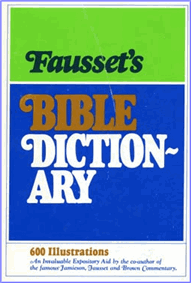Fausset's Bible Dictionary
A B C D E F G H I J K L M N O P Q R S T U V W X Y Z
Horse
In Scripture used for war-like purposes, not agriculture (except in treading out grain for threshing, Isaiah 28:28, where for "horsemen" translated "horses".) Job's magnificent description refers to the war horse (Isaiah 39:19-25), "hast thou clothed his neck with thunder?" i.e. with the power of inspiring terror. Rather "with majesty" (Umbreit), "with quivering mane" (Maurer). The Greek connection between mane (fobee) and terror (fobos) favors A.V. which is more poetic. "Canst thou make him afraid (rather 'make him spring') as a grasshopper?" So in Joel 2:4 war horses are compared to locusts. Their heads are so like that the Italian for "locust" is cavaletta, "little horse." "The glory of his nostrils is terrible: he paweth in the valley and rejoiceth in strength, he goeth on," etc.; "he swalloweth the ground with fierceness," i.e. draws it in fierce impatience toward him with his hoof, as if he would "swallow" it.
"Neither believeth he (for joy) that it is the sound of the trumpet," rather "he will not stand still at the sound." "He saith among the trumpets, Ha, ha!" his mettlesome neighing expressing his eagerness for battle, which "he smelleth," snuffeth, i.e. discerneth, "the thunder (i.e. thundering voice) of the captains." (See CHARIOT.) The donkey is the emblem of peace. The bride is compared to "a company of horses in Pharaoh's chariots" (Song of Solomon 1:9), namely, in ardor and beauty (Song of Solomon 1:4, "run"; Song of Solomon 1:5, "comely"), and in forming "a company" militant, orderly, and numerous (Revelation 19:7; Revelation 19:14). The qualities which seemed preeminent in the enemy Pharaoh's hosts at the Red Sea really belonged to Israel. Maurer translated "I compare thee to my mare in chariots of (i.e. received from) Pharaoh," but the plural "chariots" requires the collective sense "a company of horses."
The "cutting off of the horse from Jerusalem" prophetically symbolizes the cessation of war (Zechariah 9:10). Not the horse's speed or utility but his "strength" is his characteristic in Scripture (Psalm 33:17). Two names are used in Hebrew, both Persian in origin: sus from Susa, and parash from Pares. The sus was of stronger make, used for the war chariot; the parash more for riding. Perhaps in Exodus 14:9 "horsemen" mean "chariot riders." Certainly no Egyptian monument represents horsemen. Translated in 1 Kings 4:26, "forty (rather 'four,' a copyist's error, as 2 Chronicles 9:25 proves. Also 1400 chariots suit 4000 horses, two horses for each chariot and a reserve horse: 2 Chronicles 1:14; 1 Kings 10:26) thousand chariot horses and twelve thousand riding (i.e. cavalry) horses"; Ezekiel 27:14, "with (chariot) horses and riding horses" (KJV "horsemen".)
Isaiah 21:7, "a chariot with a couple of horsemen"; rather "a cavalcade of horsemen riding in pairs." In 1 Kings 4:28; Esther 8:14; Micah 1:13, rekesh "dromedary"; rather "a courser," a "racehorse," for such purposes as the royal post. In 1 Kings 10:28-29, the sense seems that the Egyptians regularly brought horses to a mart in S. Israel (Septuagint and Vulgate name the mart in their translation), of the Hebrew Koa. In A. V. Mi-Kveh is translated "linen yarn") and handed them to the king's dealers at a fixed price, 150 shekels for one horse, 600 for a chariot, including its two draught horses and one reserve horse. In Genesis 12:15 horses are not mentioned among the possessions which Abram acquired during his sojourn in Egypt. But in Genesis 47:17 they stand foremost among the Egyptians' possessions. In later times, the greater contact of Egypt with Canaanite and Arab nomads' accounts for the introduction of horses.
The camel, one of Abram's possessions in Egypt, is not mentioned in Joseph's time nor on the Egyptian monuments. Their early possession of the desert of Sinai makes it certain they knew and must have used the camel there, "the ship of the desert," but they avoid mentioning it as being unclean. Saddles were not used until a late period. Horses' hoofs hard "as flint" were a good point in days when shoeing was unknown (Isaiah 5:28). White horses were emblematic of victory (Revelation 6:2; Revelation 19:11; Revelation 19:14). Horses were consecrated to the sun, since that luminary was supposed to drive a fiery chariot through the sky (2 Kings 23:11). They were driven in procession to meet the rising sun.
Bibliography Information
Fausset, Andrew Robert M.A., D.D., "Definition for 'horse' Fausset's Bible Dictionary".
bible-history.com - Fausset's; 1878.
Copyright Information
© Fausset's Bible Dictionary
Fausset's Bible Dictionary Home
Bible History Online Home
Bible Encyclopedia (ISBE)
Online Bible (KJV)
Naves Topical Bible
Smith's Bible Dictionary
Easton's Bible Dictionary
Schaff's Bible Dictionary
Fausset's Bible Dictionary
Matthew Henry Bible Commentary
Hitchcock's Bible Dictionary

Dr. A.R. Fausset
Popular and Trending:
Meaning and definition of fasting, what is fasting in the bible, fasting definition, why should I fast, the power of prayer and fasting, Location of Galilee, where was galilee in the bible?, fasting definition, Galilee region, cities of Galilee, Sea of Galilee, Definition of biblical fire, what is fire in the bible?, fire and brimstone, fire meaning, baking bread with fire, Definition of the biblical firmament in Genesis, what is the firmament in the bible?, was the firmament the third heaven, firmament meaning, did the firmament bring the flood of Noah?.
